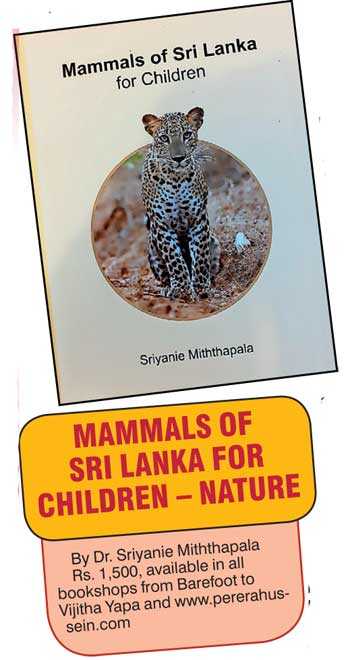Monday Mar 17, 2025
Monday Mar 17, 2025
Saturday, 17 August 2019 01:47 - - {{hitsCtrl.values.hits}}
 Education has become so competitive in the paradise isle that children will rarely be exposed to anything outside their school curriculum and sadly, even the little sport they are allowed to indulge in, is limited to an activity that will look good on their school leaving certificate.
Education has become so competitive in the paradise isle that children will rarely be exposed to anything outside their school curriculum and sadly, even the little sport they are allowed to indulge in, is limited to an activity that will look good on their school leaving certificate.
And yet, one of the most wonderful aspects of life in the tropics is the superabundance of nature around us and its easy accessibility. Animals, birds, insects, fish, reptiles and mammals abound but with our increasingly narrow focus, would we recognise them all if we saw them?
Given that we ourselves fall into the category of mammals, if we extend our interest along only that group, did you know that Sri Lanka is home to 96 species of mammals including 21 endemics? No? Well, you might not learn that in school.
What better way to indulge in some recreational or soft learning than with the work of a former educator? Dr. Sriyanie Miththapala has written many marvellous books on nature that are easily understandable and cater specifically to children, giving them a solid grasp of the world outside the classroom.
 But since we have particular empathy with the other denizens of our mammalian species, her updated and revised book ‘Mammals of Sri Lanka for Children’ gives us a fairly comprehensive overview of the surprisingly diverse beasts that populate our land.
But since we have particular empathy with the other denizens of our mammalian species, her updated and revised book ‘Mammals of Sri Lanka for Children’ gives us a fairly comprehensive overview of the surprisingly diverse beasts that populate our land.
You will learn about where they live, what they eat and how they move. You will learn the etymology of words – that mammals are so named because of their mammary glands; that endemic means unique to a particular area and that hoofed mammals like Deer are called ungulates.
Without seeming to do so, Dr. Miththapala corrects common misconceptions – that what we mistakenly refer to as Polecats are really Asian Palm Civets; that despite their scales and being thought of as reptiles, Pangolins are mammals too; and that Bats, far from being just nocturnal birds are really mammals.
But more than that, did you know that bats make up a quarter of the global living population of mammals and that there are 30 different types of Bats in Sri Lanka? Or that unexpectedly, there is only one type of Rabbit found here in Lanka – the Black-naped Hare! This encyclopaedic book which doesn’t talk down to children comes in handy as a reference tool that also lists the scientific names of featured mammals alongside their Common, Sinhala and Tamil names.
Crammed chock full photographs, illustrations and colourful, easy to understand tables, as well as a few interactive games that make learning fun, ‘Mammals of Sri Lanka for Children’ is a worthy addition to your child’s or even your own library. With its colourful, easy to read style, the book will keep you and your child turning pages, making new discoveries and absorbing useful and fascinating information.
If while reading this book, your child or even you realise a pressing need for conservation, it will be a boon to future generations as sadly, despite being protected by law, 58 of Lanka’s 96 species are threatened with extinction and in a few years’ time the only place you may find some of these creatures will be between the pages of this book.
(Sam Perera is a partner of the Perera-Hussein Publishing House which publishes culturally relevant stories by emerging and established Lankan and regional authors – for a primarily Lankan audience. Ph books are available everywhere books are sold and through www.pererahussein.com.)
Discover Kapruka, the leading online shopping platform in Sri Lanka, where you can conveniently send Gifts and Flowers to your loved ones for any event including Valentine ’s Day. Explore a wide range of popular Shopping Categories on Kapruka, including Toys, Groceries, Electronics, Birthday Cakes, Fruits, Chocolates, Flower Bouquets, Clothing, Watches, Lingerie, Gift Sets and Jewellery. Also if you’re interested in selling with Kapruka, Partner Central by Kapruka is the best solution to start with. Moreover, through Kapruka Global Shop, you can also enjoy the convenience of purchasing products from renowned platforms like Amazon and eBay and have them delivered to Sri Lanka.
Discover Kapruka, the leading online shopping platform in Sri Lanka, where you can conveniently send Gifts and Flowers to your loved ones for any event including Valentine ’s Day. Explore a wide range of popular Shopping Categories on Kapruka, including Toys, Groceries, Electronics, Birthday Cakes, Fruits, Chocolates, Flower Bouquets, Clothing, Watches, Lingerie, Gift Sets and Jewellery. Also if you’re interested in selling with Kapruka, Partner Central by Kapruka is the best solution to start with. Moreover, through Kapruka Global Shop, you can also enjoy the convenience of purchasing products from renowned platforms like Amazon and eBay and have them delivered to Sri Lanka.